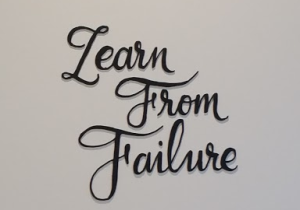Entrepreneurs have a secret ingredient. They know how to fail forward. They learn from prototypes and iterate to make their products better. Even large companies like Apple will tell you that they can’t predict the outcomes of their controlled experiments. If a product fails in the prototyping stage, they go back to the design process and build a better product. The idea of learning from failure is a core principle of the most successful companies in the world.
If we could adopt the attitude of failing forward in education, we could change the lives of many students. In education circles, I hear a lot about teaching students grit and perseverance by allowing them to learn from their mistakes. This sounds good on the surface but in a system that has traditionally categorized every student based on letter grades, this idea falls short of expectations. Time constraints often prevent students from having the opportunity to use formative assessment results to improve their assignments and resubmit. I was recently reminded of Ron Berger’s Critique and Feedback video. The video clip shows how work can improve when students are given feedback and the opportunity to learn from their mistakes.
From the day that they’re born, students are placed into categories – pretty, petite, fat, funny, smart, hyperactive. Students who are placed in one of the categories that society praises may be reluctant to move outside of the safety zone. That feeling of safety, however, can be detrimental to a student’s growth. To take a risk is to accept that you may experience failure. A college professor that I talked with recently mentioned that the students who have played it safe can be fragile. When they have a failure in college, they take it hard and don’t always have the resiliency to move forward.
Labeling students as failures is an everyday occurrence in our schools. We rank students with grades and find additional ways to predict their success or failure. When my daughter was in 6th grade, I was surprised when she came home one day with a red alphabet letter attached to her ID badge. My first reaction was that she has been tagged with a “scarlet letter.” After more questioning, I found out that all students had been tagged after taking the career interest and skills survey. She told me several stories of students who were now tagged with future careers ranging from attorneys to sanitation workers based on their current abilities. I sent her back to school with a note to have the label removed from her name badge. Good intentions to categorize and label students can be limiting.
Failure can become fate. I know too many stories of students who have not been able to overcome the F label. They drop out of high school or college. They become involved with drugs. They commit suicide. This is the real effect of labels. For those of us who survive the system and make it into successful careers, we fear failure. When something goes wrong, it’s easy to find someone else to blame. The person who accepts failure may lose status with colleagues.
So I have to ask, how can we teach students to fail forward if we’re unable to do that ourselves? Until we take a hard look at how we label students and come up with a better system, we will not be providing them with the skills for successful lives and careers. I encourage you to walk down the hallways where you work and make a list of the labels that you see. Take that list, start a conversation with colleagues and find a way to remove the barriers that we keep in place with our adherence to categorizing students based on perceived abilities. Design a prototype and fail forward to make meaningful change for our students.
